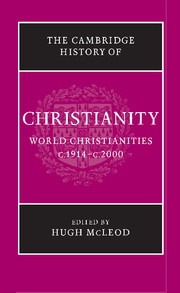Book contents
- Frontmatter
- 1 Introduction
- 2 Being a Christian in the early twentieth century
- PART I INSTITUTIONS AND MOVEMENTS
- PART II NARRATIVES OF CHANGE
- 8 The Great War
- 9 The Christian churches and politics in Europe, 1914–1939
- 10 Latin America, c.1914–c.1950
- 11 African Christianity: from the world wars to decolonisation
- 12 The African diaspora in the Caribbean and Europe from pre-emancipation to the present day
- 13 Christianity in the United States during the inter-war years
- 14 Christian churches in Australia, New Zealand and the Pacific, 1914–1970
- 15 Catholicism and Protestantism in the Second World War in Europe
- 16 The Cold War, the hegemony of the United States and the golden age of Christian democracy
- 17 The religious ferment of the sixties
- 18 The crisis of Christianity in the West: etering a post-Christian era?
- 19 The revolutions in eastern Europe and the beginnings of the post-communist era
- 20 The transformation of Latin American Christianity, c.1950–2000
- 21 Religion and racism: struggles around segregation, ‘Jim Crow’ and apartheid
- 22 Post-colonial Christianity in Africa
- 23 South Asia, 1911–2003
- 24 Christianity in South-East Asia, 1914–2000
- 25 East Asia
- PART III SOCIAL AND CULTURAL IMPACT
- Bibliography
- Index
- References
18 - The crisis of Christianity in the West: etering a post-Christian era?
from PART II - NARRATIVES OF CHANGE
Published online by Cambridge University Press: 28 March 2008
- Frontmatter
- 1 Introduction
- 2 Being a Christian in the early twentieth century
- PART I INSTITUTIONS AND MOVEMENTS
- PART II NARRATIVES OF CHANGE
- 8 The Great War
- 9 The Christian churches and politics in Europe, 1914–1939
- 10 Latin America, c.1914–c.1950
- 11 African Christianity: from the world wars to decolonisation
- 12 The African diaspora in the Caribbean and Europe from pre-emancipation to the present day
- 13 Christianity in the United States during the inter-war years
- 14 Christian churches in Australia, New Zealand and the Pacific, 1914–1970
- 15 Catholicism and Protestantism in the Second World War in Europe
- 16 The Cold War, the hegemony of the United States and the golden age of Christian democracy
- 17 The religious ferment of the sixties
- 18 The crisis of Christianity in the West: etering a post-Christian era?
- 19 The revolutions in eastern Europe and the beginnings of the post-communist era
- 20 The transformation of Latin American Christianity, c.1950–2000
- 21 Religion and racism: struggles around segregation, ‘Jim Crow’ and apartheid
- 22 Post-colonial Christianity in Africa
- 23 South Asia, 1911–2003
- 24 Christianity in South-East Asia, 1914–2000
- 25 East Asia
- PART III SOCIAL AND CULTURAL IMPACT
- Bibliography
- Index
- References
Summary
In 1996 Terence Murphy concluded a history of Canadian Christianity by declaring that ‘the concept of “Christendom” – that is of a society where Christianity and culture are essentially integrated, is gone for ever in Canada’. He went on to claim: ‘The defining reality of contemporary Canadian society is pluralism, which includes not only cultural, racial and religious diversity, but also the recognition of tolerance and of differing beliefs and customs as a basic societal value.’ In 1956, when 61 per cent of the population said they had attended a place of worship during the preceding week, Canada had ranked among the most strongly churchgoing of Western countries. By 1990 this figure had dropped to 23 per cent. This was still higher than in many European countries. But it was hardly surprising that Canadians were conscious of having entered a new era in their history.
In Britain churchgoing had never been as high, even at the peak of the Victorian religious boom, as in Canada, and by 1990 the weekly attendance rate was around 10 per cent. Callum Brown, in a much-discussed book published in 2001, felt able to adopt a more apocalyptic tone. He began:
This book is about the death of Christian Britain - the demise of the nation’s core religious and moral identity …It took several centuries …to convert Britain to Christianity, but it has taken less than forty years for the country to forsake it. For a thousand years, Christianity penetrated deeply into the lives of the people …Then really quite suddenly in 1963, something very profound ruptured the character of the nation and its people, sending organised Christianity on a downward spiral to the margins of social significance.
- Type
- Chapter
- Information
- The Cambridge History of Christianity , pp. 323 - 347Publisher: Cambridge University PressPrint publication year: 2006
References
- 2
- Cited by

